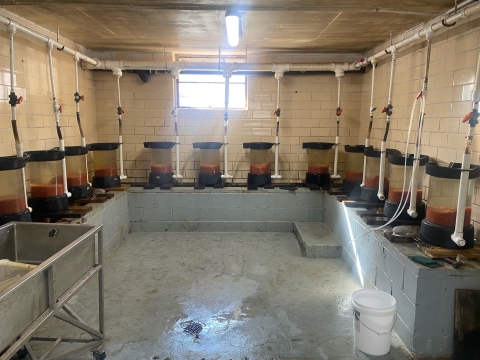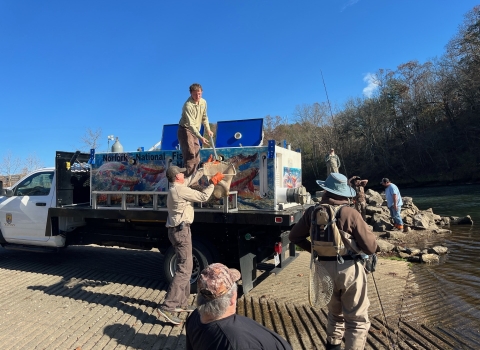December has finally arrived, and so have another batch of rainbow trout eggs here at the Norfork National Fish Hatchery. 1.6 million rainbow trout eggs... that's a lot of eggs. It is likely one of the largest single shipments of eggs ever received at Norfork NFH. Let's call it an early Christmas gift from our friends at Erwin National Fish Hatchery. No, our eggs don't actually come from here. People always see our display raceway with large trout and assume that they are brood stock. While that is a logical assumption, it isn't actually the case. We get our eggs from brood hatcheries. That means they specialize in spawning and distributing eggs to production hatcheries like the Norfork National Fish Hatchery. Without the brood hatcheries, well, Norfork NFH would operate a lot less efficiently. Thus, we are very thankful for the hard work they do. Egg shipments always bring a feeling of success. Just like witnessing growth in the fish, receiving eggs is another way to see the progress. They are a sign that a cycle of egg to stocking-sized trout has come to an end and a new one is just beginning. Those eggs also signify a lot of work in the days to come though. If you have ever wondered about the process, this article should enlighten you.
Before we get into the process of taking care of eggs once they are received, lets talk a bit about these specific eggs. This batch of eggs included eggs from two and three year old brood stock. This is typical for large egg shipments. Three year old brooders normally have larger eggs than the two year old brood stock. The most significant aspect of large egg shipments like this one is their importance to our future work. In this case, it is roughly three years of work. In three years time, there may still be fish from these eggs on site. There will be over a years worth of stocking generation from them. Talk about putting all your eggs in one basket! That's why it is important to take care of them the best we can.
Now you know where the eggs come from and what their significance is, but what happens when they get here? Honestly it is a simple process. The eggs are transported in Styrofoam coolers with trays of ice above and below them to keep them cold. When the eggs arrive here, we have to assimilate them to the hatchery's water. This means we have to ensure that the temperature of the eggs and the temperature of the water we place them in is nearly the same. Otherwise, you could give them temperature shock. After the temps are suitable, we start slowly raising the temperature up to that of the hatchery water. The eggs are then disinfected using iodine. Brood hatcheries do this before they are sent to us, but you can never be too careful. We also like to keep track of how many eggs we receive. This is done by sampling. The samples will give us the number of eggs per ounce. When the eggs go into hatching jars, we use the number of eggs per ounce to keep track of the number of eggs in each jar. There are usually around 100,000 eggs in each one of our jars. The jars keep the water circulating, providing oxygen and keeping the eggs from sticking together. Once all the eggs are in jars, we simply wait until they hatch. If you would like to know more, stop by and see us or be on the lookout for more articles.
P.S. Happy Holidays from all of us at the Norfork National Fish Hatchery!





